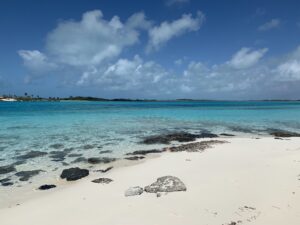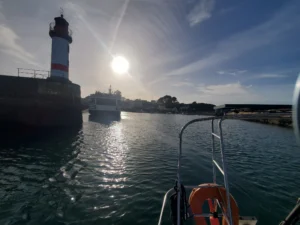Offshore sailing: find the right boat and crew?
Many people want to sail away and experience offshore sailing passage. It is not that easy even if you do have a boat. You need people to sail with, good crew and most of the time you want experienced crew. If you do not have a boat you will start to look for an offshore sailing opportunity on another boat.
Offshore sailing: Find the right and crew?
The issue for most is to find the right boat with the right captain. We compiled the most frequently asked questions about offshore sailing passages and opportunities for crew:
- Is it possible for a couple to sail together?
- What is the best time of the year?
- What are the best destination and port of departures?
- What are the most popular itineraries?
- And more…
We are happy to share our tips to help prepare your offshore passage and adventure.
Is it possible to find two places on board for an offshore sailing passage?
We do meet couples who want to live this kind of adventure together. It is not impossible, but it is a bit more difficult than finding one place. The best bet is to look for a liveaboard couple who needs crew for their passage. If you can stand a night watch you will probably be welcome on board of their boat.
Some people do not want couples on board because they do not want to witness the lovers’ honeymoon (or their arguments).
You can check crew finder websites like coboaters.com on a regular basis. Boat owners looking for couples usually clarify their need in their notice, so it is easy to find out.
What are the best ports of departure for an offshore adventure?
You can find boats leaving the Northeast pretty easily to sail to Bermuda and the Caribbean. Newport, RI is a very popular port of departure along with Annapolis, MD. Southeast ports are also popular in the fall when most boats head south to the Caribbeans.
Transatlantic crossings usually start from the Caribbeans to the Canary Islands sometimes via the Azores and/or Cape Verde Islands.
On the west coast, you best chance to start a Pacific crossing is to check boats around San Diego or San Francisco, California. You can easily sail to Hawaii and the French Polynesia. There are also great fleet of sailing vessels in Washington state and Around Vancouver, British Columbia.
When is the best time of the year to find a boat ?
Long offshore passages are weather depending. Skippers will avoid bad weather seasons and especially hurricane seasons.
Most offshore sailboats will leave the US for a passage south in the fall, most of the time after November 1st, after the hurricane season. You can join rallies and organization like Salty Dawgs and be part of a large fleet. They will return to Northern US in the spring around May and June and also most of the summer.
Offshore passages of the west coast follow the same time frame.
If you want to cross the Atlantic to Europe, you will look for atlantic sailboats in the spring. They usually leave the Caribbeans or the US in April, May or June to spend the summer in Europe and mostly in the Mediterranean. Most vessels will return to America in the fall.
Most sailboats depart from the Canary Islands from October to February to take advantage of the trade winds, strong and regular downwind at the season. The bulk of the departures from the Canary Islands are in November to arrive in early December in the Caribbeans or in the south of the US (mainly Florida).
When do you need to start looking for a boat or a crew?
It is never too early to start if you want to find the right boat or the right crew for any sailing trip but it is even more important for an offshore passage. We advise boat owners looking for crew for an offshore passage, a an Atlantic crossing or a transpacific to start at least 6 months to a year in advance to have time to evaluate candidates and even to organize test sails.
Post a notice as soon as possible on Coboaters to find crew. If you are a crew, publish a boat request notice as early as possible even if you are not yet sure of your availability. Your goal is to be identified as a possible crew for offshore experience.

The demand for offshore passage is very high and opportunities are not that common. Be proactive, contact boat owners as early as possible to establish a good relationship.
If you do not find a boat early, do not give up. There are lot of last minute requests especially if a weather event delayed most crossing. There are always people who cannot join their boat at the last minute because of unforeseen reasons. Again, the best way is to post notices, visit the website as often as possible, check Newsletters and other posts.
A lot of sailors and young travelers often choose to join a Atlantic sailboat even if the boat does not reach their final destination. They hope to jump on another sailboat for the last legs of their trip. Popular stopovers like USVI, BVI, Canary Island are good. You may just need to walk the docks and ask around to find boats.
Read our article: Do you need to be an experience crew to jump on a boat?
How long doe it take to cross the Atlantic?
An Atlantic sailboat will usually take 25 to 30 days to cross the ocean. Most boats will stop in the Azores, Cape Verde Island or Canary Islands.
In Europe, the most popular starting ports to come to America are in France (Bordeaux, La Rochelle or Les Sables d’Olonne). A lot of boats coming from Northern Europe will stop there before heading south to the Canary islands.
Remember that you can also join a delivery skipper who is paid by boat owners to deliver their boats. Delivery skippers often need volunteer crew to help them offshore.
There are many itineraries to cross the Atlantic with one, two or three stopovers:
-
From Europe to Canary Islands,
-
Canary Islands to Cape Verde or the Azores
-
and then the long crossing to Americas.

What is the best time of the year ?
Most sailboats set off for the transatlantic return trip from March to early June at the latest. Indeed, the sailboats must leave the Caribbean area early enough to avoid hurricanes, and not cross the North Atlantic too late in the season because of the lack of wind in the summer.
The classic route is to sail up the Caribbean Arc to get the best wind further north. This route takes the yachts close to the Bermuda Islands and then they cross the North Atlantic to the Azores Islands. Most of the sailboats start from Le Marin in Martinique, from Pointe à Pitre in Guadeloupe, from BVI, USVI or Saint Maarten.
Are you ready? Will you find the best boat or the best crew?
A transatlantic or offshore passage is a maritime adventure, even in the 21st century. There about 500 to 1000 sailboats crossing the Atlantic every year. Be aware that an offshore adventure is always risky, accidents happen every year and you need to prepared. Signing up for an offshore trip is not trivial.
You can join a boat even if you do not have a lot of experience and always choose a serious sailor and a well-prepared boat. Someone with a long sailing history and who prepared his offshore crossing well in advance.
Make sure you can take part of the night watch and that you are willing to be active on board for the food and the sailing activities as instructed by your skipper.
You will spend at least 20 days on board. Make sure you bring books or podcast. Most of the time, you will be out of reach during the crossing. Make sure your friends and family are aware. A long offshore passage, a transatlantic or transpacific is a great trip if you are in a transition stage: end of your studies, retirement, between two job, sabbatical year.
Be ready to share a small space (much smaller than a studio apartment) for few weeks with people you never met before. It is human experience and a real adventure, and you remember it your entire life!
Your biggest risks are boredom, seasickness and misunderstanding with another crew or with the skipper. You have to be very open minded and flexible. You will be able to have fun, exchange points of view, cook, play card with fantastic people you would probably have never met elsewhere.
Our last piece of advice for Offshore sailing
You are probably very happy and excited when you find a boat for this kind of experience but remember to stay vigilant. Do not forget the common sense recommendations for any adventure:
-
Meet and talk with the skipper and other crew members
-
Share some short sailing trips (afternoon, day or weekend)
-
If you cannot sail prior to the departure and do not see the boat, ask for pictures or videos.
-
Check other crew reviews.
You need to be confident and show others that you are ready.
And if you feel you are not yet fit for a long offshore passage, it does not matter. You have tons of sailing opportunities all around the world for shorter time and distance. You can join other boats, build your sailing network and enjoy the sea.



